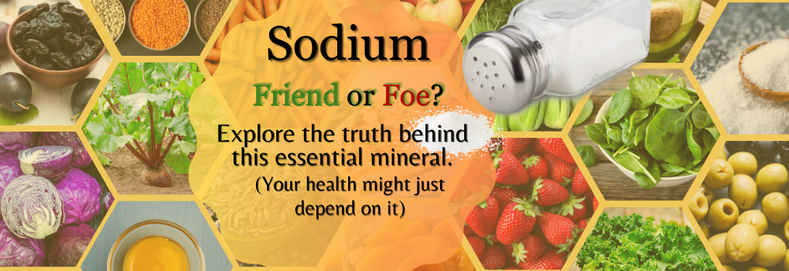Sodium - Friend or Foe?

Sodium - Friend or Foe?
After a good night's sleep you wake thirsty and reach for a glass of water. Your body is parched, but instead of water you get a glass of muddy sand.
This is what happens every day on the inside of our bodies.
The human body is between 55 - 75% water (depending on age) and needs sodium and potassium to get that water into EVERY cell in the body. Whether it’s a heart cell, a lung cell, a skin cell or a brain cell, the cells can’t get the necessary water to function without these two vital minerals - potassium and sodium.
So we eat an extra banana or drink an electrolyte drink for extra potassium, but SODIUM?
All we hear anymore is that we need a LOW sodium diet. But the biological fact is: we need sodium!
This is where the confusion sets in; the intention of this short blog is to help clear it up.
Health Care Providers are right in their advice to eat a low sodium diet in the way that MOST people consume sodium nowadays. If you look up “High Sodium Foods” online you will find foods like condiments, soft drinks, processed meats, pickles, prepackaged frozen foods, most breakfast cereals, even seemingly “healthy” foods like cottage cheese, canned vegetables, canned soups and even vegetable juice.
What you will find in most of these “high sodium” foods is our old friend “salt” or “table salt”. Salt is used for everything from preservation to flavoring and is an ingredient in the vast majority of processed foods.
Table Salt is actually the ionically-bonded rock version of sodium chloride. Unfortunately, this extremely versatile and widely used condiment, although it appears to dissolve in liquid, doesn’t actually break down or get adequately digested. Instead, the sodium remains bonded with the chlorine as tiny rocks of sodium chloride.
These tiny rocks of sodium chloride build up in areas like:
- Blood vessel walls, causing problems like high blood pressure;
- Kidneys, contributing to kidney problems;
- Heart, increasing the risk of heart attacks & strokes;
- Bones & joints, contributing to osteoporosis & arthritis.
The good news is that there is a form of sodium that is actually good for the body. It even helps clear the blockages caused by the buildup of these “micro rocks.”
By the miracle of photosynthesis, the sodium in soil becomes part of the foods growing in it. When we ingest sodium which occurs naturally in “living” foods like fresh fruits and vegetables, the sodium in these foods is digestible. The sodium and chloride break apart to be used by the body in different functions. The sodium can now work with potassium to clear away and heal areas of the body that need repair.
.
So give us a follow on Facebook here, if you haven’t already, and join us as we look at how to Live Radiantly with HEALTHY sodium foods. For more about HEALTHY sodium foods, click here.


